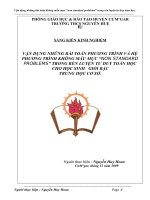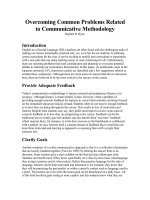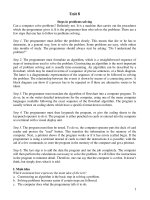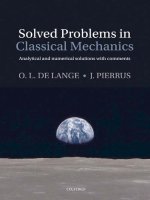Preparatory problems final2006
Bạn đang xem bản rút gọn của tài liệu. Xem và tải ngay bản đầy đủ của tài liệu tại đây (1.11 MB, 77 trang )
38th International Chemistry Olympiad * Preparatory Problems
Problem 1: “A brief history” of life in the universe
Chemistry is the language of life. Life is based on atoms, molecules and complex
chemical reactions involving atoms and molecules. It is only natural then to ask where
atoms came from. According to a widely accepted model, the universe began about 15
billion years ago in a big bang and has been expanding ever since. The history of the
universe as a whole can be viewed in terms of a series of condensations from
elementary to complex particles as the universe cooled. Of course, life as we know it
today is a special phenomenon that takes place at moderate temperatures of the Earth.
Light elements, mostly hydrogen and helium, were formed during the first several
minutes after the big bang in the rapidly expanding and, therefore, rapidly cooling early
universe. Stars are special objects in space, because temperature drop is reversed
during star formation. Stars are important in chemistry, because heavy elements
essential for life are made inside stars, where the temperature exceeds tens of millions
of degrees.
The temperature of the expanding universe can be estimated simply using:
T = 1010 / t1/2
where T is the average temperature of the universe in Kelvin (K) and t is time (age of
the universe) in seconds. Answer 1-1 through 1-6 with one significant figure. Round off
if you want.
1-1. Estimate the temperature of the universe when it was 1 second old at which time
the temperature was too high for fusion of protons and neutrons into helium nuclei
to occur.
1-2. Estimate the temperature of the universe when it was about 3 minutes old and the
nuclear synthesis of helium was nearly complete.
1-3. Estimate the age of the universe when the temperature was about 3,000 K and the
first neutral atoms were formed by the combination of hydrogen and helium nuclei
with electrons.
1-4. The first stable molecules in the universe were possible only after the temperature
of the expanding universe became sufficiently low (approximately 1,000 K) to allow
1
38th International Chemistry Olympiad * Preparatory Problems
atoms in molecules to remain bonded. Estimate the age of the universe when the
temperature was about 1,000 K.
1-5. Estimate the average temperature of the universe when the universe was about
300 million years old and the first stars and galaxies were born.
1-6. Estimate the temperature of the universe presently and note that it is roughly the
same as the cosmic microwave background measurement (3 K).
1-7. Order the following key condensations logically, consistent with the fact that over
99% of atoms in the expanding universe are hydrogen or helium.
a-( )-( )-( )-( )-( )-( )-( )-( )-( )
a. quarks → proton, neutron
b. 1014 cells → human being
c. H, C, N, O → H2, CH4, NH3, H2O (in interstellar space)
d. proton, helium nucleus + electron → neutral H, He atoms
e. proteins, nucleic acids, membrane → first cell
f. proton, neutron → helium nucleus
g. H2, He, CH4, NH3, H2O, dust → solar system
h. H, He atoms → reionization, first generation stars and galaxies
i. proton, helium nucleus (light elements)
→ heavy elements such as C, N, O, P, S, Fe, U; supernova explosion
j. H2, CH4, NH3, H2O, etc.
→ amino acids, sugars, nucleotide bases, phospholipids on Earth
2
38th International Chemistry Olympiad * Preparatory Problems
Problem 2: Hydrogen in outer space
Hydrogen is the most abundant element in the universe constituting about 75% of its
elemental mass. The rest is mostly helium with small amounts of other elements.
Hydrogen is not only abundant. It is the building block of all other elements.
Hydrogen is abundant in stars such as the sun. Thus the Milky Way galaxy,
consisting of over 100 billion stars, is rich in hydrogen. The distance between stars is
several light years on the average. Hydrogen is also the major constituent of the
interstellar space. There are about 100 billion galaxies in the universe. The empty
space between galaxies is vast. For example, the Milky Way galaxy is separated from
its nearest neighbor, the Andromeda galaxy, by 2 million light years. Hydrogen again is
the primary constituent of the intergalactic space even though the number density is
much less than in the interstellar space. The average density of matter in the
intergalactic space, where the current temperature is the cosmic background energy of
2.7 K, is about 1 atom/m3.
2-1. Calculate the average speed, (8RT/πM)1/2, of a hydrogen atom in the intergalactic
space.
2-2. Calculate the volume of a collision cylinder swept out by a hydrogen atom in one
second by multiplying the cross-sectional area, πd2, by its average relative speed
where d is the diameter of a hydrogen atom (1 x 10 -8 cm). Multiply the average
speed by square root of 2 to get the average relative speed. Molecules whose
centers are within the cylinder would undergo collision.
2-3. Calculate the number of collisions per second experienced by a hydrogen atom by
multiplying the above volume by the number density. How many years does it take
for a hydrogen atom to meet another atom in the intergalactic space?
2-4. Calculate the mean free path λ of hydrogen in the intergalactic space. λ is the
average distance traveled by a particle between collisions.
Hydrogen atoms are relatively abundant in interstellar regions within a galaxy, there
being about 1 atom per cm3. The estimated temperature is about 40 K.
2-5. Calculate the average speed of hydrogen atom in the interstellar space.
3
38th International Chemistry Olympiad * Preparatory Problems
2-6. Calculate the mean free path (λ) of hydrogen in the interstellar space.
2-7. What do these results imply regarding the probability of chemical reactions in
space?
4
38th International Chemistry Olympiad * Preparatory Problems
Problem 3: Spectroscopy of interstellar molecules
Atoms in interstellar space seldom meet. When they do (most likely on ice surfaces),
they produce radicals and molecules. These species, some of which presumably
played a role in the origin of life, have been identified through the use of different
spectroscopic methods. Absorption spectra of interstellar species can be observed by
using the background radiation as the energy of excitation. Emission spectra from
excited species have also been observed. Simple diatomic fragments such as CH and
CN were identified in interstellar space over 60 years ago.
3-1. The background electromagnetic radiation in the interstellar space has a
characteristic energy distribution related to the temperature of a blackbody source.
According to Wien’s law, the wavelength ( λ) corresponding to the maximum light
intensity emitted from a blackbody at temperature T is given by Tλ = 2.9 x 10-3 m
K. Let’s consider a region near a star where the temperature is 100 K. What is the
energy in joule of a photon corresponding to the peak emission from a blackbody
at 100 K?
When molecules with non-zero dipole moments rotate, electromagnetic radiation can
be absorbed or emitted. The spectroscopy related to molecular rotation is called
microwave spectroscopy, because the electromagnetic radiation involved is in the
microwave region. The rotational energy level of a diatomic molecule is given by EJ =
J(J+1)h2/8π2I where J is the rotational quantum number, h is the Planck constant, I is
the moment of inertia, µR2. The quantum number J is an integer increasing from 0 and
the reduced mass µ is given by m1m2/(m1+m2) for diatomic molecules (m1 and m2 are
masses of the two atoms of the molecule). R is the distance between the two bonded
atoms (bond length).
3-2. Carbon monoxide is the second most abundant interstellar molecule after the
hydrogen molecule. What is the rotational transition (change of J quantum
number) with the minimum transition energy? What is the minimum transition
energy of the 12C16O rotation in joule? The bond length of CO is 113 pm. Compare
the transition energy of CO with the radiation energy in problem 3-1. What does
the result imply? The distribution of molecules in different energy levels is related
to the background temperature, which affects the absorption and emission spectra.
5
38th International Chemistry Olympiad * Preparatory Problems
Figure 3-1. Oscillogram for the lowest rotational transition of
12
C16O at 115,270
MHz. The upper curve was taken at the temperature of liquid air, the lower at
the temperature of dry ice. (Reference: O. R. Gilliam, C. M. Johnson and W.
Gordy. Phys. Rev. vol. 78 (1950) p.140.)
3-3. The equation for the rotational energy level is applicable to the rotation of the
hydrogen molecule. However, it has no dipole moment so that the transition of ∆J
= 1 by radiation is not allowed. Instead a very weak radiative transition of ∆J = 2 is
observed. Calculate the temperature of interstellar space where the photon energy
at the maximum intensity is the same as the transition energy of the hydrogen
molecule (1H2) between J = 0 and 2. The H-H bond length is 74 pm.
6
38th International Chemistry Olympiad * Preparatory Problems
Problem 4: Ideal gas law at the core of the sun
Life on Earth has been made possible by the energy from the sun. The sun is a typical
star belonging to a group of hydrogen-burning (nuclear fusion, not oxidation) stars
called main sequence stars. The core of the sun is 36% hydrogen (1H) and 64% helium
(4He) by mass. Under the high temperature and pressure inside the sun, atoms lose all
their electrons and the nuclear structure of a neutral atom becomes irrelevant. The vast
space inside atoms that was available only for electrons in a neutral atom becomes
equally available for protons, helium nuclei, and electrons. Such a state is called
plasma. At the core of the sun, the estimated density is 158 g/cm 3 and pressure 2.5 x
1011 atm.
4-1. Calculate the total number of moles of protons, helium nuclei, and electrons
combined per cm3 at the core of the sun.
4-2. Calculate the percentage of space occupied by particles in hydrogen gas at 300 K
and 1 atm, in liquid hydrogen, and in the plasma at the core of the sun. The
density of liquid hydrogen is 0.09 g/cm 3. The radius of a nuclear particle can be
estimated from r = (1.4 x 10-13 cm)(mass number)1/3. Assume that the volume of a
hydrogen molecule is twice that of a hydrogen atom, and the hydrogen atom is a
sphere with the Bohr radius (0.53 x 10-8 cm). Estimate your answer to 1 significant
figure.
4-3. Using the ideal gas law, estimate the temperature at the core of the sun and
compare your result with the temperature required for the fusion of hydrogen into
helium (1.5 x 107 K).
7
38th International Chemistry Olympiad * Preparatory Problems
Problem 5: Atmosphere of the planets
The solar system was born about 4.6 billion years ago out of an interstellar gas cloud,
which is mostly hydrogen and helium with small amounts of other gases and dust.
5-1. The age of the solar system can be estimated by determining the mass ratio
between Pb-206 and U-238 in lunar rocks. Write the overall nuclear reaction for
the decay of U-238 into Pb-206.
5-2. The half-life for the overall reaction is governed by the first alpha-decay of U-238 (
238
92 U
→ 234
90 Th +
4
2
He), which is the slowest of all reactions involved. The half-life for
this reaction is 4.51 x 109 yr. Estimate the mass ratio of Pb-206 and U-238 in lunar
rocks that led to the estimation of the age of the solar system.
Elemental hydrogen and helium are rare on Earth, because they escaped from the
early Earth. Escape velocity is the minimum velocity of a particle or object (e.g., a gas
molecule or a rocket) needed to become free from the gravitational attraction of a
planet. Escape velocity of an object with mass m from the Earth can be determined by
equating minus the gravitational potential energy, -GMm/R, to the kinetic energy,
(1/2)mv2, of the object. Note that the m’s on both sides cancel and, therefore, the
escape velocity is independent of the mass of the object. However, it still depends on
the mass of the planet.
G: the universal constant of gravitation = 6.67 x 10-11 N m2 kg-2
M: Earth’s mass = 5.98 x 1024 kg
R: Earth's radius = 6.37 x 106 m
5-3. Calculate the escape velocity for the Earth.
5-4. Calculate the average speed, (8RT/πM)1/2, of a hydrogen atom and a nitrogen
molecule at ambient temperature. Compare these with the escape velocity for the
Earth. Note that the temperature of the upper atmosphere where gases can
escape into space will be somewhat different. Also note that photolysis of water
vapor by ultraviolet radiation can yield hydrogen atoms. Explain why hydrogen
8
38th International Chemistry Olympiad * Preparatory Problems
atoms escape more readily than nitrogen molecules even though the escape
velocity is independent of the mass of the escaping object.
The chemical composition of the atmosphere of a planet depends on the temperature
of the planet’s atmosphere (which in turn depends on the distance from the sun,
internal temperature, etc.), tectonic activity, and the existence of life.
As the sun generated heat, light, and solar wind through nuclear fusion of
hydrogen to helium, the primitive inner planets (Mercury, Venus, Earth, and Mars) lost
most of their gaseous matter (hydrogen, helium, methane, nitrogen, water, carbon
monoxide, etc.). As the heavy elements such as iron and nickel were concentrated at
the core through gravity and radioactive decay produced heat, internal temperature of
the planets increased. Trapped gases, such as carbon dioxide and water, then
migrated to the surface. The subsequent escape of gases from the planet with a given
escape velocity into space depends on the speed distribution. The greater the
proportion of gas molecules with speed exceeding the escape velocity, the more likely
the gas is to escape over time.
5-5. Circle the planet name where the atmospheric pressure and composition are
consistent with the given data. Explain.
Average surface temperature and radius of the planet are as follows:
Venus: 730 K; 6,052 km
Earth: 288 K; 6,378 km
Jupiter: 165 K; 71,400 km
Pluto: 42 K; 1,160 km
pressure (in atm)
composition (%)
Mars: 218 K; 3,393 km
planet
a.
> 100
H2(82); He(17)
(Venus, Earth, Mars, Jupiter, Pluto)
b.
90
CO2(96.4); N2(3.4)
(Venus, Earth, Mars, Jupiter, Pluto)
c.
0.007
CO2(95.7); N2(2.7)
(Venus, Earth, Mars, Jupiter, Pluto)
d.
1
N2(78); O2(21)
(Venus, Earth, Mars, Jupiter, Pluto)
e.
10-5
CH4(100)
(Venus, Earth, Mars, Jupiter, Pluto)
5-6. Write the Lewis structure for H2, He, CO2, N2, O2, and CH4. Depict all valence
electrons.
9
38th International Chemistry Olympiad * Preparatory Problems
5-7. All of the above atmospheric components of the planets are atoms and molecules
with low boiling point. Boiling point is primarily determined by the overall polarity of
the molecule, which is determined by bond polarity and molecular geometry.
Nonpolar molecules interact with dispersion force only and, therefore, have low
boiling points. Yet there are differences in boiling points among nonpolar
molecules. Arrange H2, He, N2, O2, and CH4 in the order of increasing boiling point.
Explain the order.
10
38th International Chemistry Olympiad * Preparatory Problems
Problem 6: Discovery of the noble gases
Molecules such as H2, N2, O2, CO2, and CH4 in Problem 5 are formed through chemical
bonding of atoms. Even though valency was known in the 19 th century, the underlying
principle behind chemical bonding had not been understood for a long time. Ironically,
the discovery of the noble gases with practically zero chemical reactivity provided a
clue as to why elements other than the noble gases combine chemically.
1882, Rayleigh decided to accurately redetermine gas densities in order to test Prout's
hypothesis.
6-1. What is Prout's hypothesis? What evidence did he use to support his hypothesis?
(Search the Internet or other sources.)
To remove oxygen and prepare pure nitrogen, Rayleigh used a method recommended
by Ramsay. Air was bubbled through liquid ammonia and was passed through a tube
containing copper at red heat where the oxygen of the air was consumed by hydrogen
of the ammonia. Excess ammonia was removed with sulfuric acid. Water was also
removed. The copper served to increase the surface area and to act as an indicator. As
long as the copper remained bright, one could tell that the ammonia had done its work.
6-2. Write a balanced equation for the consumption of oxygen in air by hydrogen from
ammonia. Assume that air is 78% nitrogen, 21% oxygen, and 1% argon by volume
(unknown to Rayleigh) and show nitrogen and argon from the air in your equation.
6-3. Calculate the molecular weight of nitrogen one would get from the density
measurement of nitrogen prepared as above. Note that argon in the sample,
initially unknown to Rayleigh, did contribute to the measured density. (atomic
weight: N = 14.0067, Ar = 39.948)
Rayleigh also prepared nitrogen by passing air directly over red-hot copper.
6-4. Write a balanced equation for the removal of oxygen from air by red-hot copper.
Again show nitrogen and argon from the air in your equation.
11
38th International Chemistry Olympiad * Preparatory Problems
6-5. Calculate the molecular weight of nitrogen one would get from the density
measurement of the nitrogen prepared by the second method.
6-6. To Rayleigh’s surprise, the densities obtained by the two methods differed by a
thousandth part – a difference small but reproducible. Verify the difference from
your answers in 6-3 and 6-5.
6-7. To magnify this discrepancy, Rayleigh used pure oxygen instead of air in the
ammonia method. How would this change the discrepancy?
6-8. Nitrogen as well as oxygen in the air was removed by the reaction with heated Mg
(more reactive than copper). Then a new gas occupying about 1% of air was
isolated. The density of the new gas was about (
) times that of air.
6-9. A previously unseen line spectrum was observed from this new gas separated
from 5 cc of air. The most remarkable feature of the gas was the ratio of its specific
heats (Cp/Cv), which proved to be the highest possible, 5/3. The observation
showed that the whole of the molecular motion was (
). Thus, argon is a
monatomic gas.
(1) electronic
(2) vibrational
(3) rotational
(4) translational
6-10. Calculate the weight of argon in a 10 m x 10 m x 10 m hall at STP.
In 1894, Rayleigh and Ramsay announced the discovery of Ar. Discovery of other
noble gases (He, Ne, Kr, Xe) followed and a new group was added to the periodic
table. As a result, Rayleigh and Ramsay received the Nobel Prizes in physics and in
chemistry, respectively, in 1904.
6-11.
Element names sometimes have Greek or Latin origin and provide clues as to their
properties or means of discovery. Match the element name with its meaning.
helium •
neon
•
• new
• stranger
argon •
• lazy
krypton •
• hidden
12
38th International Chemistry Olympiad * Preparatory Problems
xenon •
• sun
13
38th International Chemistry Olympiad * Preparatory Problems
Problem 7: Solubility of salts
The solubility of metals and their salts played an important role in Earth's history
changing the shape of the Earth's surface. Furthermore, solubility was instrumental in
changing the Earth's atmosphere. The atmosphere of the primitive Earth was rich in
carbon dioxide. Surface temperature of the early Earth was maintained above the
boiling point of water due to continued bombardment by asteroids. When the Earth
cooled, it rained and a primitive ocean was formed. As metals and their salts dissolved
the ocean became alkaline and a large amount of carbon dioxide from the air dissolved
in the ocean. The CO2 part of most carbonate minerals is derived from this primitive
atmosphere.
As life arose about 3.8 billion years ago and photosynthetic bacteria evolved about
3 billion years ago, molecular oxygen was produced as a by-product of photosynthesis.
As oxygen reacted with the metal ions in the ocean, metal oxides with low solubility
were deposited on the ocean floor which later became dry land through plate tectonic
motion. Iron and aluminum ores were, and still are, of particular importance as raw
materials in human civilization.
Let's consider a solubility problem using silver halides. Ksp values for AgCl and AgBr
are 1.8×10-10 and 3.3×10-13, respectively.
7-1. Excess AgCl was added to deionized water. Calculate the concentration of Cl - in
equilibrium with solid AgCl. Repeat the calculation for Br - assuming that AgBr was
added instead of AgCl.
7-2. Assume that 0.100 L of 1.00×10 -3 M Ag+ solution is added to a Cl- solution of the
same volume and concentration. What is the concentration of Cl - in the solution
once equilibrium has been established? What percentage of the total chloride is in
solution?
7-3. Assume that 0.100 L of 1.00×10-3 M Ag+ solution is added to a Br- solution of the
same volume and concentration. What is the concentration of Br - in the solution
once equilibrium has been established? What percentage of the total bromide is in
solution?
14
38th International Chemistry Olympiad * Preparatory Problems
7-4. Experimental verification of the answers in 7-2 and 7-3 is difficult, because the
exact volume and concentration of the solutions are unknown. Repeat the
calculations in 7-2 and 7-3 assuming that the concentration of the Ag + solution is
1.01×10-3 M.
Now let's assume that 1.00×10-3 M Ag+ solution is slowly added with constant stirring to
a 0.100 L solution containing both Cl- and Br- at 1.00×10-3 M concentration.
7-5. Which silver (I) halide will precipitate first? Describe the situation when the first
precipitate appears.
7-6. Determine the percentage of Br-, Cl-, and Ag+ ions in solution and in the precipitate
after addition of 100, 200, and 300 mL of Ag+ solution.
Vadd
% Br
% Br in
% Cl
% Cl in
% Ag
% Ag in
in solution precipitate in solution precipitate in solution precipitate
100 mL
200 mL
300 mL
15
38th International Chemistry Olympiad * Preparatory Problems
Problem 8: Physical methods for determination of Avogadro’s number
Avogadro's number is a fundamental constant in chemistry. However, an accurate
determination of this value took a long time. Avogadro (1776-1856) himself did not
know Avogadro's number as it is known today. At about the time of his death,
Avogadro's number determined from gas properties, such as diffusion coefficient and
viscosity, approached 5 x 1022. Avogadro's number as we know it today (6.02 x 10 23)
became available only in the early 20th century. Let's consider three separate
approaches.
8-1. At thermal equilibrium, the probability of finding a molecule with a mass m at height
h is proportional to the Boltzmann factor, exp(-E(h)/kBT), where E(h) is the
gravitational potential energy (mgh, where g is 9.81 m/s2) and kB is the Boltzmann
constant. Thus, the number density at h follows "barometric" distribution:
ρ ( h)
− mg ( h − ho )
= exp
k BT
ρ (h0 )
(a) Spherical particles of diameter 0.5 μm and density 1.10 g/cm 3 are suspended in
water (density 1.00 g/cm3) at 20°C. Calculate the effective mass m of the particles
corrected for buoyancy.
(b) Now the number density of the particles with effective mass will follow barometric
distribution. In an experiment where a vertical distribution of such particles was
measured, it was observed that the number density at h decreased to 1/e times
the number density at ho over a vertical distance of 6.40×10 -3 cm. Calculate
Boltzmann’s constant.
(c) Calculate Avogadro's number using Boltzmann’s constant and the gas constant.
(R = 8.314 J/mol⋅ K)
8-2. Avogadro's number can also be determined by single crystal X-ray crystallography.
The density of sodium chloride crystal is 2.165 g/cm 3. The sodium chloride lattice
is shown below (Figure 8-1). The distance between the centers of adjacent Na +
and Cl- ions was determined to be 2.819 x 10-8 cm. Calculate Avogadro's number.
16
38th International Chemistry Olympiad * Preparatory Problems
Figure 8-1. Lattice structure of sodium chloride
In the rock-salt structure one finds a face-centered cubic array of anions and the same
array of cations. The two arrays interpenetrate each other. A unit cell contains 4 anions
(8 centered at the apexes are each shared by 8 unit cells thus giving 1 anion, and 6
positioned at the face centers are each shared by 2 unit cells giving 3 anions). A unit
cell also contains 4 cations.
8-3. In a celebrated oil drop experiment, Millikan determined in 1913 that the basic unit
of electric charge is 1.593 x 10-19 coulombs. Calculate Avogadro's number from this
value and Faraday, which is electric charge per equivalent (1 Faraday = 96,496
coulomb as used by Millikan).
17
38th International Chemistry Olympiad * Preparatory Problems
Problem 9: An electrochemical method for determination of Avogadro's
number
By definition, Avogadro's number is the number of atoms in exactly 12 g of carbon-12.
Avogadro's number recommended by CODATA (Committee on Data for Science and
Technology) in 2002 is 6.0221415(10)×1023 mol-1, where the number in parenthesis
represents one standard deviation in the last two digits.
Avogadro's number can be determined electrolytically. Current and time are
measured in order to obtain the number of electrons passing through the
electrochemical cell from Q = I·t (charge = current x time). Copper electrodes were
used for electrolysis of 0.5 M H 2SO4. During electrolysis, copper is lost from the anode
as the copper atoms are converted to copper ions. The copper ions pass through the
solution. At the surface of the cathode, hydrogen gas is liberated through reduction of
hydrogen ions in the acidic solution. Experimental results are as follows:
decrease in anode mass: 0.3554 g
constant current: 0.601 A
time of electrolysis: 1802 s
Note that 1 A = 1 C/s or 1 A·s = 1 C and the charge of one electron is 1.602 x 10–19 C.
9-1. Write the reactions at both the anode and cathode.
9-2. Calculate the total charge that passed through the circuit.
9-3. Calculate the number of electrons involved in the electrolysis.
9-4. Calculate the mass of a copper atom.
9-5. Determine Avogadro's number. Atomic weight of copper is 63.546 g/mol.
9-6. What is the percent error in this measurement of Avogadro's number?
9-7. It is also possible in principle to collect the hydrogen gas evolved and use its
weight to determine Avogadro's number. Calculate the weight of evolved hydrogen
gas. Is this determination of Avogadro's number from the weight of evolved
hydrogen practical?
18
38th International Chemistry Olympiad * Preparatory Problems
Problem 10: Enthalpy, entropy, and stability
All chemical changes in living and non-living systems obey laws of thermodynamics.
The equilibrium constant of a given reaction is determined by changes in Gibbs free
energy, which is in turn determined by enthalpy change, entropy change, and the
temperature.
10-1.
Fill in the blanks (a-f) with all that apply from the following:
equilibrium constant, Keq
entropy change, ΔS
enthalpy change, ΔH
free energy change, ΔG
a. strongly temperature-dependent
(
)
b. closely related to bond strength
(
)
c. measure of change in randomness
(
)
d. related to the quantity of reactants and products
(
)
e. measure of spontaneity of a reaction
(
)
f. measure of heat released or absorbed
(
)
The following equilibrium exists in the vapor phase dissociation of molecular addition
compounds of donor molecules, D, and boron compounds, BX3.
D⋅ BX3(g) ↔ D(g) + BX3(g)
Kp = [D][BX3]/[D·BX3]
10-2. Dissociation constants (Kp) at 100°C of the molecular addition compounds
Me3N·BMe3 and Me3P·BMe3 are 0.472 and 0.128 atm, respectively. Calculate the
standard free energy change of dissociation at 100°C for both compounds. Which
complex is more stable at this temperature?
10-3. The standard entropy change of dissociation, ΔS°, is 45.7 cal/mol⋅ K for
Me3N⋅ BMe3 and 40.0 cal/mol⋅ K for Me3P⋅ BMe3. Calculate the standard enthalpy
change of dissociation for both compounds. Which compound has the stronger
central bond? Assume that ΔH and ΔS are temperature-independent.
19
38th International Chemistry Olympiad * Preparatory Problems
10-4. Which is more critical in determining the overall stability of these addition
compounds at 100°C, enthalpy term (ΔH) or entropy term (T ΔS)?
10-5. At what temperature does Me3N⋅ BMe3 become more thermodynamically stable
than Me3P⋅ BMe3? Assume that ΔH and ΔS are temperature-independent.
20
38th International Chemistry Olympiad * Preparatory Problems
Problem 11: Lewis acids and bases
Acids and bases are essential for life. Amino acids have both acidic and basic groups.
DNA and RNA are nucleic acids that contain bases such as adenine, guanine, thymine,
cytosine, and uracil. Thus, understanding acid-base chemistry is essential for
understanding life. Oxygen was so named by Lavoisier because of its acid-forming
nature; the acid-forming nature of oxygen is a manifestation of its high electronegativity.
Lewis extended the definition of acids and bases, and electronegativity is again central
in understanding Lewis acidity and basicity.
11-1. Describe the molecular structure of BX3. What is the hybridization of the boron
orbitals?
11-2. How does this hybridization change when the boron halide forms an adduct with
a base such as pyridine (C5H5N)? Is the structural change around boron upon
adduct formation more favorable when X is F or I? List BF 3, BCl3, and BBr3 in the
order of increasing Lewis acidity based on the above structural consideration.
11-3. Electronegativity is another important consideration in predicting Lewis acidity.
List BF3, BCl3, and BBr3 in the order of increasing Lewis acidity, based only on the
electronegativity of the halogen elements (inductive effect).
11-4. Is adduct formation between the boron halide (Lewis acid) and pyridine (Lewis
base) exothermic or endothermic? Which Lewis acid will show the greatest
enthalpy change upon adduct formation?
11-5. Although the gaseous state would be best for computing the relative strengths of
the three boron halides under consideration, the liquid state of these materials
could be used as a satisfactory reference state since the boron halides are
relatively non-polar liquids or gases.
The enthalpy changes when mixing liquid boron halide with nitrobenzene, ΔH1,
and when mixing the nitrobenzene-boron halide solution with pyridine also in
nitrobenzene, ΔH2, are given below.
BX3(liq.) + C6H5NO2(liq.) → C6H5NO2⋅ BX3 (soln.)
ΔH1
C6H5NO2⋅ BX3(soln.) + C5H5N(soln.) → C5H5N⋅ BX3(soln.) + C6H5NO2(soln.)
ΔH2
21
38th International Chemistry Olympiad * Preparatory Problems
BF3
BCl3
BBr3
ΔH1 (kcal/mol)
- 6.7
- 8.7
- 12.5
ΔH2 (kcal/mol)
- 25.0
- 30.8
- 32.0
Calculate ΔH3 for the following reactions. Do they agree with your prediction in
11-4?
BX3(liq.) + C5H5N(soln.) → C5H5N⋅ BX3(soln.)
11-6. Boron halides also show very different reactivity with water. BF3 forms stable
addition compounds whereas BCl3 and BBr3 react violently with H2O at
temperatures below 20°C. Predict the products, A, B, and C, for the following
reactions.
BF3 + H2O → A
BCl3 (or BBr3) + 3H2O → B + C
11-7. What kind of extra bond can be formed in BX 3 between the central boron and one
of its halides possessing lone pair electrons in order to fulfill the ‘octet rule’?
Explain how this extra bond affects the Lewis acidity of BX3.
22
38th International Chemistry Olympiad * Preparatory Problems
Problem 12: Solubility equilibrium in a buffer solution
Biochemical reactions take place in buffered aqueous environments. For example, the
pH of the blood is maintained around 7.4 by the buffering action of carbonate,
phosphate, and proteins. Many chemical reactions in the laboratory are also carried out
in buffer solutions. In this problem, let’s consider the solubility equilibrium in a buffer
solution.
12-1. H2S gas occupying 440 mL at STP can be dissolved in 100 mL of water at 25 oC.
Calculate the molar concentration of H2S in water saturated with H2S. Assume that
there is no volume change in water upon dissolution of H2S.
12-2. Assume that equilibrium is established after a 0.010 M FeCl 2 solution is saturated
with H2S by continuously bubbling H2S into the solution.
Ksp(FeS) = [Fe2+][S2-] = 8.0 x 10-19 at 25oC
(1)
For acid dissociation of H2S,
K1 = [H+][HS-]/[H2S] = 9.5 x 10-8
+
2-
-
K2 = [H ][S ]/[HS ] = 1.3 x 10
(2)
-14
(3)
For self ionization of water,
Kw = [H+][OH-] = 1 x 10-14
(4)
In the solution, the positive charge is balanced by the negative charge:
[H+] + 2[Fe2+] = [Cl-] + [OH-] + [HS-] + 2[S2-]
(5)
Cross out terms that are negligibly small in the charge balance equation, (5),
in order to determine [H+] and [Fe2+]. Would you increase or decrease the pH of the
solution to precipitate more FeS? How does the increase of 1 in pH affect the
concentration of Fe2+ ion?
12-3. How would you adjust the final pH of the solution saturated with H 2S to reduce
the concentration of Fe2+ from 0.010 M to 1.0 x 10-8 M?
23
38th International Chemistry Olympiad * Preparatory Problems
12-4. You want to use acetic acid (HOAc)/sodium acetate (NaOAc) buffer to achieve
1.0 x 10-8 M concentration of Fe2+ as described above. Suppose that you are
making the buffer by mixing acetic acid and sodium acetate in water in a
volumetric flask. Enough acetic acid was added to make the initial concentration
0.10 M. Considering that the precipitation reaction produces H+ (Fe2+ + H2S →
FeS(s) + 2H+), how would you adjust the initial concentration of sodium acetate to
obtain 1.0 x 10-8 M Fe2+ after equilibrium is established? The acid dissociation
constant for acetic acid at 25oC is 1.8 x 10-5.
12-5. What is the pH of the buffer before H2S is introduced and FeS is precipitated?
24
38th International Chemistry Olympiad * Preparatory Problems
Problem 13: Redox potential, Gibbs free energy, and solubility
The proton, neutron, and electron are the three sub-atomic particles important in
chemistry. These particles occupy two regions. Proton and neutron occupy the central
place of the nucleus and electron the vast space outside the nucleus.
Neutron transfer does not take place in ordinary chemical reactions. Proton
(hydrogen ion) transfer constitutes acid-base reactions. Electron transfer constitutes
oxidation-reduction reactions. Oxidation-reduction reactions are essential for life.
Photosynthesis and respiration are two prime examples. Oxidation-reduction reactions
also allow key thermodynamics quantities to be measured as demonstrated in this
problem.
Given the following information:
Ag+(aq) + e– → Ag(s)
E° = 0.7996 V
AgBr(s) + e– → Ag(s) + Br–(aq)
E° = 0.0713 V
ΔGf°(NH3(aq)) = –26.50 kJ/mol
ΔGf°(Ag(NH3)2+(aq)) = –17.12 kJ/mol
+1.441 V
V HOBr +1.584 V Br2(aq) ? Br–(aq)
BrO3–(aq) +1.491
→
→
→
13-1. Calculate ΔGf°(Ag+(aq)).
13-2. Calculate the equilibrium constant for the following reaction at 25°C.
Ag+(aq) + 2 NH3(aq) → Ag(NH3)2+(aq)
13-3. Calculate the KSP value of AgBr(s) at 25°C.
13-4. Calculate the solubility of AgBr in a 0.100 M aqueous solution of ammonia at
25°C.
13-5. A galvanic cell using the standard hydrogen electrode as an anode is constructed
in which the overall reaction is
25









